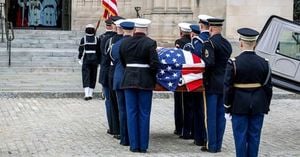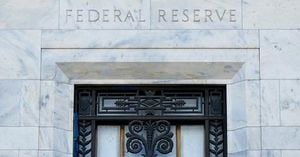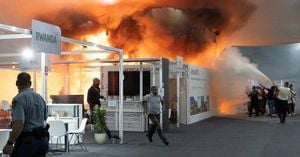Two years after wildfires tore through Lahaina, Hawaii, the scars left on the island’s young people remain raw and stubbornly unhealed. The blazes that swept through the town in 2023 were devastating by any measure—claiming 102 lives and damaging more than 3,300 properties. But for hundreds of Maui’s students, the trauma has lingered, manifesting in anxiety, depression, and a pervasive sense of loss that has proven difficult to shake.
The Hawaii Department of Education estimates that more than a third of Maui’s students either lost a family member, suffered a serious injury, or had a parent lose a job as a direct result of the fires, according to reporting by the Associated Press. For many, the disaster was only the beginning of a long, uncertain journey toward recovery—a journey complicated by a shortage of mental health resources and the relentless stress of displacement and change.
Mia Palacio, a senior at Lahainaluna High School, knows this struggle all too well. Palacio told Honolulu Civil Beat that after the fires, she felt isolated and angry, moving between high schools and never feeling truly welcome. Her family, like so many others, lacked a permanent place to stay. The pain, she said, only intensified as the months dragged on. Near the first anniversary of the fires, Palacio finally reached out for help. With the support of a school counselor and a local organization that provides outdoor-based mental health support, she began to find her footing. Now, she takes pride in mentoring younger students who are also wrestling with the aftermath.
Palacio’s story is far from unique. According to a 2024 study by the University of Hawaii, more than half of children who survived the Lahaina fires reported symptoms of depression, roughly 30% likely faced an anxiety disorder, and nearly half were experiencing post-traumatic stress disorder (PTSD). The study, led by researcher Christopher Knightsbridge, found that two years after the disaster, students were grappling with a toll that went beyond the immediate trauma. "While kids may feel numb immediately following a disaster, after two years, they’re facing the toll of constant uncertainty and change," Knightsbridge explained to CalMatters. "The crisis isn’t over."
For many students, the triggers are everywhere. DayJahiah Valdivia, a senior at Kīhei Charter School, told Centro de Periodismo Investigativo that her stress spikes whenever strong winds blow or when small brush fires ignite nearby. Though her home in Upcountry Maui was spared during the 2023 wildfires, the months spent cleaning soot and worrying about loved ones took a heavy toll. Even now, Valdivia says, the anxiety never really wears off—especially on windy days, when concentrating in class becomes nearly impossible.
The mental health crisis among Maui’s youth is compounded by a severe shortage of specialists. In recent years, the number of psychiatrists serving young people on the island has dropped from four to just two, even as demand has soared. Maui’s high cost of living and persistent housing shortages have made it difficult to attract and retain mental health professionals, a problem that predates the fires and has only worsened since, according to AP and CalMatters reporting.
Efforts to address this gap have faced significant obstacles. The Hawaii Department of Education received a $2 million federal grant to support students, but hiring qualified staff has proven challenging. In the first nine months of the grant, much of the funding was used to bus displaced students from other parts of the island back to Lahaina schools. Five part-time mental health providers were hired, but as of summer 2025, two of six behavioral health specialist positions in Lahaina schools remained unfilled, as reported by Honolulu Civil Beat. Kimberly Lessard, a district specialist, explained that the ongoing housing shortage and high cost of living were major barriers to recruitment.
The result is long wait times for care. Valdivia, for example, is on a two- to three-month waiting list to see a psychiatrist on Maui, and has resorted to telehealth sessions with a therapist based on Oʻahu. "Even just to get evaluated (by a psychiatrist), it’s literally months," she said. "I just think that’s crazy."
With traditional mental health services stretched thin, some nonprofits and therapists have turned to creative solutions. Loren Lapow, a social worker and founder of the Maui Hero Project, offers adventure-based counseling services that immerse teens in outdoor activities like paddleboarding and disaster preparedness workshops. Lapow’s approach, described by AP as "adventure-based counseling," encourages teens to reflect on their fears and losses in a supportive environment. "Places are like a friend to us," Lapow told a group of teens one June afternoon. "When you lose places, it hurts."
But these programs don’t always reach those who need them most. There is a strong stigma around seeking mental health services in Filipino and Latino communities, which make up a significant portion of Lahaina’s population. Ruben Juarez, a University of Hawaii professor and lead researcher on the fire survivor study, told Centro de Periodismo Investigativo that families may view counseling as a sign of weakness, and children may fear being judged or scrutinized. Yet the study found that Latino teens reported the highest rates of severe depressive and PTSD symptoms, while Filipino teens had some of the highest rates of anxiety.
Recognizing the need for culturally sensitive support, the state is piloting new approaches to reach struggling youth. A program called YouthLine will train Hawaii teens to respond to crisis calls, in hopes that students will be more comfortable opening up to peers. Keli Acquaro, who oversees youth mental health for the state, expressed optimism that peer-led support could help bridge the gap.
Some survivors are determined to turn their pain into purpose. Keakealani Cashman, who lost her home to the fires, spent her senior year at Kamehameha Schools Maui researching how Native Hawaiian cultural values—like connections to the land and ancestors—can aid in healing. The project, she told Honolulu Civil Beat, helped her own mental health improve. Now entering her second year at Brigham Young University Hawaii, Cashman hopes to become a behavioral health specialist and support future generations. "This horrible, horrible thing happened to me and my family, but I don’t have to let it kill the rest of my life," she said. "I can really help my family, my community in school, and just make an impact in what I know how to do."
As Lahaina’s students and families continue to rebuild their lives, the path forward remains uncertain. But in the face of immense adversity, their resilience—and the community’s ongoing efforts to support them—offer a glimmer of hope for healing and renewal.



